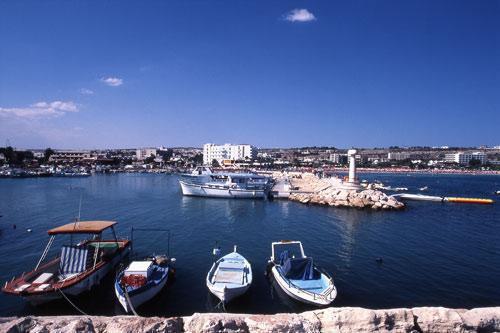- Our Municipality
- Services
- Visitors
- Information
- Documents
- Contacts
History of Agia Napa
The Agia Napa region is characterized by the lack of rivers, and the scarcity of cultivated land. Therefore the distribution of settlements by period corresponds exactly to the possibilities of the land. The discovery in 2004 of a new early site at Nissi Beach, on coastal formations of aeolianite, dating back to 8.500 - 10.500 B.C. marks the short presence of the first seafaring foragers on the island. The first Neolithic inhabitants, however, came much later and settled for a short period of time on a naturally protected hill-top near the coast called Tigani before moving inland. For five millennia the area was not populated, as no traces of the Chalcolithic, Bronze Age and Geometric periods have so far been located.
The Cypro-Archaic and Cypro-Classical remains were once again located on a small promontory right on the coast. We do not know much about these people, as the only remains we have are but a few fragments of terracotta figurines from an improvised sanctuary situated on the beach at the site of Makronisos. The Hellenistic period is well represented by the sanctuary of Aphrodite on the table-shaped hill referred to by Strabo and described by Ohnefalsch-Richter as well as by the results of the excavations at Makronisos. The burial customs are practically Greek and correspond to that of other cemeteries of the same periods all over Cyprus particularly Salamis and Pafos. The pottery found in tombs suggests contacts with foreign countries, especially the Greek eastern world including Syria and Anatolia, North Africa and Italy.
The Roman period was notable for the erection of a number of farmsteads resulting from the establishment of the Pax Romana. Strongholds such as Palio Chorko continued their existence but the economy of the region was from now on based on individual farms. Little is known about the organization of the region, but the existence of a major town is evident in the later part of the Roman period. Both Strabo and Ptolemaios refer to "Thronoi city and cape". The remains of Thronoi were found at the site of Torno west of the present village. Thronoi was the most important settlement while some minor settlements like Ziyagin and Kaounin were related to it. The extensive water-works at the locality of FiIina could be considered as part of the activities of an organized community residing at Thronoi. A number of quarries in the region provide further evidence for the organization of the society and the specialization of labour.
Most of the major settlements of the Roman period continue their existence well into the Early Christian period. The most important settlement, however, of the Early Christian and Early Byzantine period is Katalymata. It seems that most of the population shifted here to this new site where no remains of the pagan past were present. The settlement was a flourishing one, judging from the remains. The site was in its turn abandoned during the Arab raids of the 7th century along with other minor sites.
The region was deserted for centuries and most likely only shepherds wandered about the pastures until the 14th century, when the Lusignans, attracted by the charm of the region, built the Agia Napa Monastery. Gradually but steadily some people came into the region shortly after the erection of the monastery, either as work force for the construction of the aqueduct or as suppliers for the monks. Many of them settled permanently around the monastery and developed into the community. The village of Agia Napa became a reality which continued down to the present day. A small community of farmers and fishermen grew to a town towards the end of the 20th century.
For further reading on the archaeology and monuments of the region see:
Cesnola, L.Palma di. 1877. Cyprus: Its Ancient Cities, Tombs and Temples. London.Enlart, C. 1899. L'Art gothique et la Renaissance en Chypre. Paris. Gothic Art and the Renaissance in Cyprus. English edition translated and edited by Sir David Hunt. London 1987.Hadjisavvas, S. 1983. "New Light on the History of Agia Napa Region" Report of the Department of Antiquities, Cyprus. 161-166.Hadjisavvas, S. 1997. Agia Napa. Excavations at Makronisos and the Archaeology of the Region. Nicosia.Hadjisavvas, S. 2008. The Agia Napa Aqueduct. Nicosia. Dr Sophocles Hadjisavvas. March 2009



















